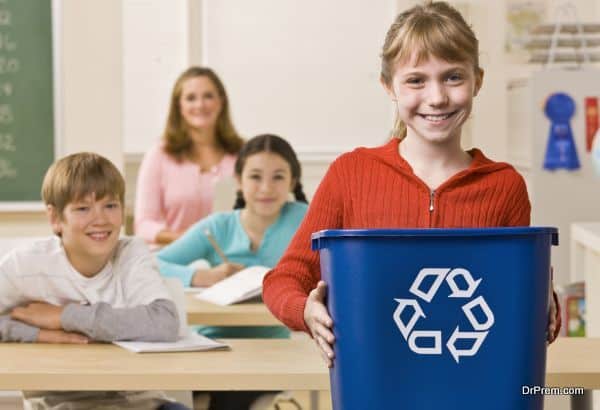The best way to ensure that the next generation learns to adopt sustainable ways of living is to teach them the same from a very young age itself. And the best way of achieving that is by bringing sustainability into the classroom. Accordingly, here are some simple but really effective tips that would help make classrooms more sustainable as well as
Make indoor areas healthier
You can save a lot of energy by simply setting the temperature to reasonable levels depending on the weather outside. Let your students know about the same so that they come dressed accordingly. Keep a few indoor plants in the class to improve air quality, thereby ensuring that your classroom is a healthier haven for students.
Encourage recycling
There are plenty of ways in which you can encourage students in the class to actively take part in recycling programs. For instance, keep a different colored bin for different recyclable materials (paper, plastic, glass, etc.) and educate your students on how to use them indoors as well as outdoors. Split the students into groups and create games that would enable them to get into the spirit of recycling.
Minimize paper waste
Opt to use recycled paper for handouts and exams. Print on both sides of the paper and use smaller margins. Negligible differences withholding, use as well as ask your students to opt for used books of the same edition in order to prevent wastage of paper. Better yet, opt for an online syllabus wherein your students can mail in their assignments to you rather than writing them down on paper.
Opt for greener lunches
Lunchtime in the classroom would usually spell a lot of waste in the form of plastic bottles and containers as well as leftovers being dumped in the trash. Avoid all this by asking your students to bring only the necessary amount of food they would need to avoid wasting them in the end. Encourage them to ditch plastic containers and bottles in favor of reusable ones. If your school has a garden, encourage your students to grow foods locally to be supplied to the cafeteria. And place a compost bin inside the classroom to collect organic waste which can then be used to make compost for the outdoor garden.
Encourage more energy efficient practices
Schools can tend to use over 25% of their energy for the lights alone. You can start an energy efficient ‘Turn off Lights’ campaign to encourage students to switch off the lights as well as any other electrical appliance that is not being used. Use a power strip to plug in all the electronics in the class and turn off this strip when class is finished for the day. Also ensure that unused computers are placed on sleep mode as this would also help reduce energy usage by up to 40%.
Opt for natural lighting
Why opt for artificial lights when you have the sun to supply with all natural, cost effective brightness? Open the blinds and windows at every other opportunity to let in as much natural light into the class as possible. In addition to minimizing the need for lights in the room, this move can in fact increase productivity to a great extent as witnessed in many studies relating productivity and daylight.
Take sustainability outdoors as well
Encourage your students to extend their sustainable goals outside the classroom as well. For instance, you can ask them to carpool to school, even volunteering if you have a car. Picking up students along the way will ensure that they reduce their carbon footprint significantly while commuting to school. Start campaigns to encourage students to walk to school as well if their homes are nearby. This will also help reduce their carbon footprint to an extent.
Summary
Sustainability is best taught at a young age itself. These tips will help you preach as well as practice the concept with your students to transform the classroom as well as the surrounding areas into more sustainable spaces.


